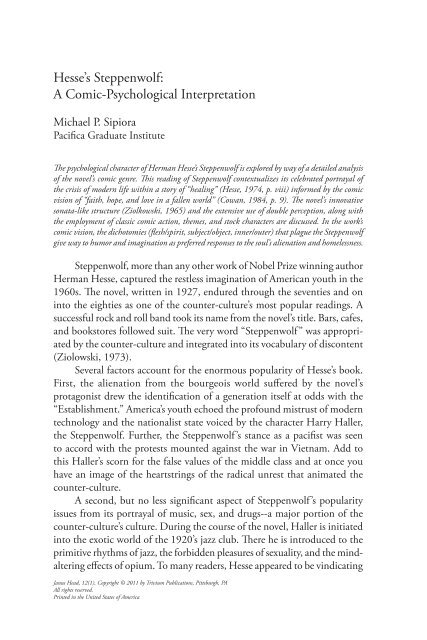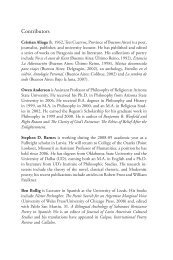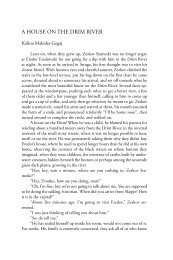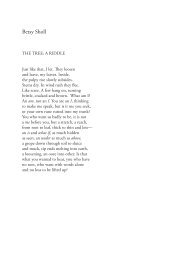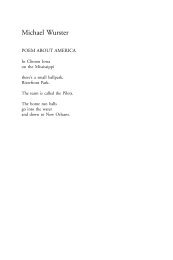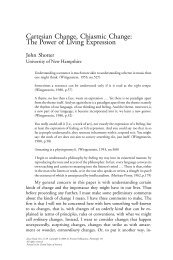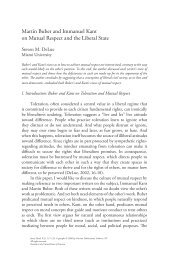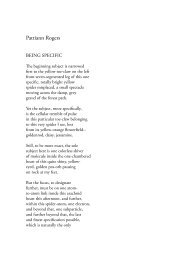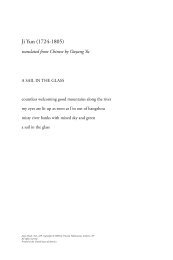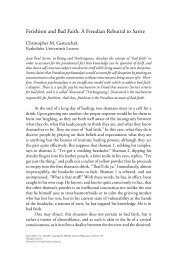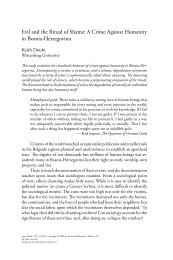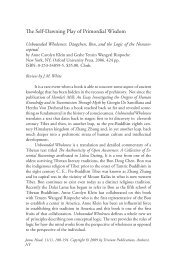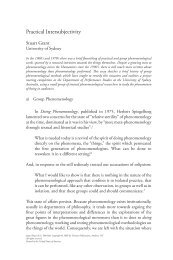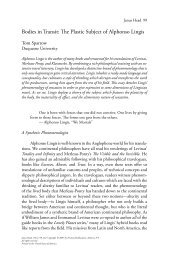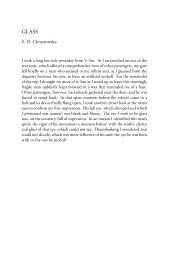Hesse's Steppenwolf: A Comic-Psychological ... - Janus Head
Hesse's Steppenwolf: A Comic-Psychological ... - Janus Head
Hesse's Steppenwolf: A Comic-Psychological ... - Janus Head
Create successful ePaper yourself
Turn your PDF publications into a flip-book with our unique Google optimized e-Paper software.
Hesse’s <strong>Steppenwolf</strong>:<br />
A <strong>Comic</strong>-<strong>Psychological</strong> Interpretation<br />
Michael P. Sipiora<br />
Pacifica Graduate Institute<br />
�e psychological character of Herman Hesse’s <strong>Steppenwolf</strong> is explored by way of a detailed analysis<br />
of the novel’s comic genre. �is reading of <strong>Steppenwolf</strong> contextualizes its celebrated portrayal of<br />
the crisis of modern life within a story of “healing” (Hesse, 1974, p. viii) informed by the comic<br />
vision of “faith, hope, and love in a fallen world” (Cowan, 1984, p. 9). �e novel’s innovative<br />
sonata-like structure (Ziolkowski, 1965) and the extensive use of double perception, along with<br />
the employment of classic comic action, themes, and stock characters are discussed. In the work’s<br />
comic vision, the dichotomies (flesh/spirit, subject/object, inner/outer) that plague the <strong>Steppenwolf</strong><br />
give way to humor and imagination as preferred responses to the soul’s alienation and homelessness.<br />
<strong>Steppenwolf</strong>, more than any other work of Nobel Prize winning author<br />
Herman Hesse, captured the restless imagination of American youth in the<br />
1960s. �e novel, written in 1927, endured through the seventies and on<br />
into the eighties as one of the counter-culture’s most popular readings. A<br />
successful rock and roll band took its name from the novel’s title. Bars, cafes,<br />
and bookstores followed suit. �e very word “<strong>Steppenwolf</strong>” was appropriated<br />
by the counter-culture and integrated into its vocabulary of discontent<br />
(Ziolowski, 1973).<br />
Several factors account for the enormous popularity of Hesse’s book.<br />
First, the alienation from the bourgeois world suffered by the novel’s<br />
protagonist drew the identification of a generation itself at odds with the<br />
“Establishment.” America’s youth echoed the profound mistrust of modern<br />
technology and the nationalist state voiced by the character Harry Haller,<br />
the <strong>Steppenwolf</strong>. Further, the <strong>Steppenwolf</strong>’s stance as a pacifist was seen<br />
to accord with the protests mounted against the war in Vietnam. Add to<br />
this Haller’s scorn for the false values of the middle class and at once you<br />
have an image of the heartstrings of the radical unrest that animated the<br />
counter-culture.<br />
A second, but no less significant aspect of <strong>Steppenwolf</strong>’s popularity<br />
issues from its portrayal of music, sex, and drugs--a major portion of the<br />
counter-culture’s culture. During the course of the novel, Haller is initiated<br />
into the exotic world of the 1920’s jazz club. �ere he is introduced to the<br />
primitive rhythms of jazz, the forbidden pleasures of sexuality, and the mindaltering<br />
effects of opium. To many readers, Hesse appeared to be vindicating<br />
<strong>Janus</strong> <strong>Head</strong>, 12(1), Copyright © 2011 by Trivium Publications, Pittsburgh, PA<br />
All rights reserved.<br />
Printed in the United States of America
124 <strong>Janus</strong> <strong>Head</strong><br />
the value of rock and roll, free love, and the use of marijuana and psychedelic<br />
drugs. Timothy Leary went so far as to recommend <strong>Steppenwolf</strong> as a guide<br />
to the use of LSD in inducing altered states of consciousness: “�e last part<br />
of <strong>Steppenwolf</strong> is a priceless manual” (quoted in Ziolowski, 1973, p. 12).<br />
“Poetic writing,” ventures Hesse in his 1961 preface to the novel’s<br />
English translation, “can be understood and misunderstood in many ways.<br />
. . . Yet it seems to me that of all my books <strong>Steppenwolf</strong> is the one that was<br />
more often and more violently misunderstood . . .” (1974, p. vii). Hesse<br />
goes on to speculate that one reason for the misunderstanding may lie in<br />
the fact that many of the work’s readers are young people while the problems<br />
that the book deals with are those of a fifty year old man. But then<br />
again, Hesse notes the numbers of his own generation who failed to grasp<br />
the work’s significance. Certainly the book tells of grief and suffering, of<br />
the crisis of modern life; yet, writes Hesse, “still it is not a book of a man<br />
despairing, but of a man believing” (1974, p. viii). �e story tells not only<br />
of the <strong>Steppenwolf</strong>’s “problematic life,” but also of the “Indestructible . . .<br />
world of faith” (Hesse, 1974, p. viii). “I would be happy,” Hesse concludes,<br />
“if many of them were to realize that the story of the <strong>Steppenwolf</strong> pictures<br />
a disease and crisis--but not one leading to death and destruction, on the<br />
contrary: to healing” (1974, p. viii).<br />
“Faith, believing, healing”--with these words Hesse directs attention<br />
to the action which underlies his novel, the action missed by so many of<br />
its readers. �e author asks that we recognize and appreciate the current of<br />
imagination which flows through the <strong>Steppenwolf</strong>’s story. �is is no less<br />
than the perfectly valid request that our interpretation acknowledge the<br />
genre to which the work belongs.<br />
“Literary genres,” writes the philosopher Jose Ortega y Gasset, “are the<br />
poetic functions, the directions in which esthetic creation moves” (1963, p.<br />
112). Genres are the grand metaphors, the archetypal patterns that vitalize<br />
literary works. �e audience’s awareness of the vista of imagination from<br />
which a particular poetic work issues makes a great deal of difference in how<br />
they will view that work. <strong>Steppenwolf</strong>’s vision is not one in which grief, suffering,<br />
and despair hold the dominant place in human existence. Its vision<br />
is not tragic, even in the most common use of the term. �e action of the<br />
psyche, which <strong>Steppenwolf</strong> makes visible, moves in the opposite direction<br />
towards endurance and health; its genre is comedy. Comedy, according to<br />
the literary critic, Louise Cowan—to whose genre theory the present essay is<br />
greatly indebted—speaks of “faith, hope, and love in a fallen world” (1984,
<strong>Janus</strong> <strong>Head</strong> 125<br />
p. 9). �e comic vision embraces life through imagination and instills in<br />
us the belief that things can go well in this life. “�e message of the book,”<br />
Hesse wrote, “is how to endure life . . .” (quoted in Bolby, 1967, p. 202).<br />
Such a message is the heart of comedy. Comedy performs a recovery of<br />
life’s vital rhythm that, when read carefully, is what <strong>Steppenwolf</strong> is meant<br />
to accomplish.<br />
�e task at hand, then, is to interpret <strong>Steppenwolf</strong>, Hesse’s most popular<br />
and misunderstood novel, as a poetic work of the comic imagination. �e<br />
motivation for such an undertaking is not to serve the author (although in<br />
the case of a writer so often wrongly praised--and equally unjustly maligned<br />
as Hesse--this service is honorable). Rather, the motivation reaches beyond<br />
the author to the facilitation of the reader’s vision and so to the cultivation<br />
of the imagination of which <strong>Steppenwolf</strong> is a literary embodiment. Such a<br />
reading both clarifies the novel’s genre, and, as we shall see, illuminates its<br />
psychological character.<br />
�e Story and Its Structure<br />
<strong>Steppenwolf</strong> is the story of Harry Haller recounted in the form of his<br />
own manuscripts. An ailing, alienated, and despondent intellectual, Haller,<br />
who is fast approaching his fiftieth year, despairs of life’s meaning. Personal<br />
life and professional career have collapsed and he is adrift in a world that<br />
offers neither place nor peace. His wanderings bring him to an old city,<br />
familiar from his past, where he resides for a time under the pretext of using<br />
the renowned library. He takes a room in a sedate middle class home but<br />
proceeds to live a secluded and tortured existence apart from the house’s<br />
ambiance of bourgeois orderliness and self-satisfaction.<br />
Steeped in the works of Novalis and Nietzsche, Haller indulges in relentless,<br />
venomous introspection finding that his sick and aging body is the<br />
abode of two souls: one a man, a burger, and the other a beast, a lone wolf of<br />
the Steppes. �is duality between flesh and spirit rents his troubled existence<br />
and has plagued Haller for many years. He is attracted to the bourgeois world<br />
and yet at the same time repelled by it. �e realm outside the bourgeois<br />
claims him, but he cannot endure it. �e <strong>Steppenwolf</strong> is caught in a vicious<br />
duality in which the two sides of his soul make war on each other, leaving<br />
his life a bloodied field of self-hatred and recriminations. Under the savage<br />
attack of a divided will turned against life, Haller seeks escape in the timeless<br />
world of philosophy, art, and music. And failing that, in alcohol.
126 <strong>Janus</strong> <strong>Head</strong><br />
On one of his nocturnal prowls, the <strong>Steppenwolf</strong> encounters a mysterious<br />
sign on an ancient, barren wall: “Magic �eatre, For Madmen Only.”<br />
Subsequently, he encounters an equally mysterious vendor who provides<br />
him with a nondescript pamphlet. Upon returning to his lair, Haller<br />
discovers that what he has obtained is none other than a “Treatise on the<br />
<strong>Steppenwolf</strong>.” �is tract, written from the perspective of the immortal<br />
world for which Haller longs, is a philosophical and psychological analysis<br />
of the <strong>Steppenwolf</strong>’s dual existence. A solution is offered but in magical<br />
terms that Haller does not comprehend. However, the Treatise does make<br />
a profound impression, echoing as it does sentiments Haller has transcribed<br />
in poetry. But, it does not alter his conviction that the ultimate resolution<br />
of his dilemma rests on the edge of his razor; he has reserved suicide as his<br />
most viable alternative.<br />
Several days later, a dinner engagement with a former colleague turns<br />
into a disaster. �e <strong>Steppenwolf</strong> vehemently objects to his hostess’ domesticated<br />
portrait of Haller’s revered Goethe, while his host expresses no less<br />
virulent loathing for the traitorous political writings of the pacifist Haller.<br />
A deeply troubled Haller is left roaming the dark streets convinced that the<br />
razor which waits in his room is the tool of his fate. Quite drunk from visits<br />
to taverns on his path, and weary of trying to fend off the inevitable return<br />
to his lodgings, the <strong>Steppenwolf</strong> discovers himself below the sign of the<br />
Black Eagle--a nightclub/bordello mentioned to him earlier in the day by<br />
a man whom he had mistaken for the mysterious pamphlet vendor. Inside,<br />
the evening’s festivities are in full swing. Haller feels himself very much out<br />
of place but cannot bring himself to leave. Pushed to the bar by the surges<br />
of the crowd, he is thrust into the company of a beautiful and fashionable<br />
prostitute. Hermine (as Haller later discovers is her name) exerts an uncanny<br />
charm over the <strong>Steppenwolf</strong>. Taking the situation in hand, Hermine orders<br />
food and drink for the desperate suicide. She chides him for his foolish despondence<br />
and at the same time initiates a pact of obedience in which the<br />
<strong>Steppenwolf</strong> is to submit to her tutelage in the art of life.<br />
During the weeks which follow, Hermine teaches Haller to dance<br />
and introduces him to the popular culture of abandon of the twenties. She<br />
leads the skittish wolf into the risqué and heady world of the jazz nightclub.<br />
Haller behaves as a dutiful student but strains under the contradictions<br />
such a lifestyle presents to his ingrained rejection of the contemporary, the<br />
physical, and the spontaneous. Hermine sends her sister courtesan, Maria,<br />
to school the lonesome wolf in the subtle pleasures of the flesh. Moreover,
<strong>Janus</strong> <strong>Head</strong> 127<br />
she introduces Haller to her friend Pablo, a jazz musician of singular detachment<br />
who possesses an alchemist’s knowledge of narcotics and other<br />
exotic drugs.<br />
Participation in a grand masked ball is the culmination of the <strong>Steppenwolf</strong>’s<br />
apprenticeship. �ere Haller falls completely under Hermine’s spell<br />
and celebrates his newly learned appreciation of life in a Dionysian revelry<br />
which lasts well into the night. When morning brings the ball to an exhausted<br />
close, Pablo guides Hermine and Haller through a drug induced finale to the<br />
<strong>Steppenwolf</strong>’s re-education. Under the influence of opium, Haller enters the<br />
Magic �eatre--a series of fantasies revealing the multidimensional nature<br />
of the <strong>Steppenwolf</strong>’s soul. Although Haller fails a final test of his renewed<br />
existence, he nonetheless emerges from the �eatre with a fuller acceptance<br />
of life’s endless possibilities and with hope for their attainment.<br />
<strong>Steppenwolf</strong>, for all of its popularity, is not an easy novel to read. �is<br />
fact alone makes a comic interpretation difficult as readers expect a comedy<br />
to be more easily accessible than, for example, a tragedy. Yet Hesse, not unlike<br />
Shakespeare in Midsummer Night’s Dream and �e Tempest, makes<br />
considerable demands on his audience’s capacity for interpretive reading.<br />
Hesse’s friend �omas Mann insists, “as an experimental novel, <strong>Steppenwolf</strong><br />
is no less daring than Ulysses and �e Counterfeiters” (1967, p.<br />
ix). Hesse himself, responding to criticisms that the novel lacked a coherent<br />
structure, contended that it is the most tightly constructed of his works and<br />
that it is “compositionally . . . like a sonata” (quoted in Ziolowski, 1965, p.<br />
192). In an effort to facilitate the proposed comic reading of <strong>Steppenwolf</strong>,<br />
�eodore Ziolkowski’s (1965) authoritative elucidation of the novel’s sonata<br />
structure will be utilized.<br />
<strong>Steppenwolf</strong> is divided into three main sections or movements. �e<br />
first movement, which Ziolkowski labels “preliminary material,” (1965, p.<br />
181) is in turn divided into three sub-sections. �e novel begins with an<br />
introduction authored by the man in whose aunt’s house Haller stayed and<br />
in whose possession the <strong>Steppenwolf</strong>’s manuscript came to rest. �is man<br />
is a self-proclaimed, typical bourgeois to whom Haller’s experiences are<br />
an alien world. �e introduction contains both this gentlemen’s personal<br />
recollections of Haller and his own analysis of the <strong>Steppenwolf</strong>’s character.<br />
Subsection two is the beginning of Haller’s account proper. It contains<br />
some of the events related in the introduction as well as a more detailed<br />
picture of the <strong>Steppenwolf</strong>’s existence given from his own perspective. �e<br />
concluding subsection of the first movement comprises the “Treatise on the
128 <strong>Janus</strong> <strong>Head</strong><br />
<strong>Steppenwolf</strong>,” a copy of which Haller has included in his manuscript. In<br />
Ziolkowski’s analysis, these three subdivisions correspond to “the classical<br />
structure for the opening section of a sonata” (1965, p. 189). Two themes,<br />
that of the <strong>Steppenwolf</strong> and the burger--the two parts of Haller’s soul--are<br />
introduced in the first division. In the following subsection these themes are<br />
developed and interpreted in terms of their significance in Haller’s life. �e<br />
third subsection recapitulates the two themes and proposes their resolution.<br />
�us <strong>Steppenwolf</strong>’s first movement follows sonata form: two themes are set<br />
forth, developed, and then restated.<br />
�e second movement contains the novel’s action which takes place<br />
during a several week period leading up to and including the masked ball.<br />
�is is the time during which Haller is instructed by Hermine. In this second<br />
movement the themes from the first division are further developed through<br />
what Ziolkowski describes as the literary equivalent of the musical device<br />
of counterpoint: double perception (1965, pp. 195-199). Double perception<br />
is a technique employed by Hesse in order to render the simultaneous<br />
existence of two levels of reality. Double perception, like counterpoint<br />
which, according to the Howard Dictionary of Music combines “into a<br />
single musical fabric” lines which have “distinctive melodic significance,”<br />
(quoted in Ziolkowski, 1965, p. 198) brings the real and the imaginal into<br />
play at the same time. �e net result of this double vision in <strong>Steppenwolf</strong><br />
is the collapse of dichotomies: flesh/spirit, real/unreal, and subject/object.<br />
Double perception communicates Hesse’s conception of magical thinking<br />
as the free exchange of inner and outer realities and the perception of their<br />
essential unity. �e fantastic events around which all of the novel’s action<br />
revolves—attaining the Treatise, the relationship with Hermine, the Magic<br />
�eatre, etc.—each rely in one way or another, on magical thinking.<br />
�e Magic �eatre is the <strong>Steppenwolf</strong> sonata’s third and final movement.<br />
Ziolkowski refers to this movement as a “theme with variations,”<br />
and as the work’s “finale” (1965, pp. 216, 224). Here Hesse explores the<br />
multiplicity of personality, one of <strong>Steppenwolf</strong>’s central themes, by composing<br />
variations on motifs already present in the previous two sections. �e<br />
succession of fantasies experienced by Haller in the Magic �eatre is episodic<br />
amplifications of chords struck during the course of Haller’s re-education.<br />
�e novel reaches its finale in a waking dream in which the <strong>Steppenwolf</strong><br />
understands the significance of the initiation he has undergone.
<strong>Comic</strong> Patterns, �emes, and Characters<br />
<strong>Janus</strong> <strong>Head</strong> 129<br />
Ziolkowski’s insightful analysis provides more than a valuable framework<br />
for discussion of the complex novel. It also reveals how Hesse’s art has<br />
fashioned the <strong>Steppenwolf</strong>’s intricate tale into a cohesive structure which<br />
reflects the novel’s concern with the polyvalent existence of the real and the<br />
polymorphous nature of the human soul. While these two concerns accord<br />
with the comic tradition’s preoccupation with imagination as the preferred<br />
response to life’s difficulties, analysis of <strong>Steppenwolf</strong>’s form also discloses<br />
its affinity with the structures of comedy. <strong>Steppenwolf</strong> follows the general<br />
comic pattern of resolving a conflict through a fortunate series of events that<br />
climax in a celebration. In addition, each of the novel’s movements makes<br />
use of specific comic forms and devices.<br />
�e role of the Treatise in the first movement closely resembles that of<br />
the chorus in Attic Comedy. �e Treatise makes its appearance in the story<br />
after a prologue in which the burger and the <strong>Steppenwolf</strong> each present their<br />
respective views of Haller’s conflict. Like the chorus of Attic Comedy, the<br />
Treatise voices a perspective on the conflict which is detached from the distress<br />
of the characters. �is perspective issues from a higher realm, another<br />
world which the chorus brings into the play. �e chorus points to a resolution<br />
of the conflict, thus marking the direction which the rest of the story<br />
will take, that direction usually being one of imagination and fantasy, as is<br />
the case in <strong>Steppenwolf</strong>. And not unlike the authors of Attic Comedy who<br />
would address the audience directly by way of the chorus, Hesse presents<br />
his own psychology, his own personality theory, in the Treatise.<br />
<strong>Steppenwolf</strong>’s second movement, relying as it does on double perception,<br />
is full of the tricks, deceptions and chance encounters which typify<br />
comedy from Aristophanes to Shaw. �roughout the novel the operations<br />
of Fortune are elicited to reinstate Haller in the order of life. �e comic<br />
devices employed all work toward the good, and have a didactic dimension.<br />
�e <strong>Steppenwolf</strong>’s apprenticeship to Hermine is symbolic of the novel’s<br />
educational intent. <strong>Steppenwolf</strong> is about, as Hesse remarks, “enduring life”<br />
(quoted in Bolby, 1967, p. 202) specifically, life in the city. �e story’s urban<br />
setting (–another comic motif), while inspired by the actual cities of Basel<br />
and Zurich, is the early twentieth-century city in which the breakdown of<br />
culture is most acutely felt. Hesse gives us a city in which the memory of<br />
the old and the developments of modernity provide a workshop in which<br />
imaginative experiments in living can occur and lead to a new response to
130 <strong>Janus</strong> <strong>Head</strong><br />
the conflicts of the soul’s life in the human community.<br />
�e Magic �eatre, <strong>Steppenwolf</strong>’s finale, makes use of a wide range<br />
of comic episodes from the romantic interlude of New Comedy to the<br />
bizarre happenings of �eatre of the Absurd. �e use of episodes which<br />
are not directly related to the main action is a time honored practice of<br />
the writers of comedy. Like a rhetorical digression, these episodes diverge<br />
from the storyline only to later return to the action, bringing a heightened<br />
awareness of the story or a twist of fate which ultimately bears on the story’s<br />
outcome. �e episodes of the Magic �eatre do both. �ey not only develop<br />
the multiplicity of Haller’s personality, but they also set the stage for the<br />
novel’s final scenes.<br />
Despite the novel’s comic structure, there can be no doubt but that<br />
<strong>Steppenwolf</strong> begins as tragedy, to use Ziolkowski’s phrase, “the tragedy of<br />
intellect in despair” (1974, p. 179). Haller, as an intellectual--that is, as<br />
one who has cultivated the thoughts and sentiments of the past and who<br />
in turn thinks deeply about the present--is caught between two worlds,<br />
caught between the Old World of refinement and the brash new world of<br />
modernity. �e <strong>Steppenwolf</strong> suffers the breakdown of the myths which<br />
have structured society. “Human life,” observes Haller, “is reduced to real<br />
suffering, to hell, only when two ages, two cultures and religions overlap”<br />
(Hesse, 1974, p. 24).<br />
Such an inferno is the <strong>Steppenwolf</strong>’s hellish existence. Yet this fate is not<br />
the <strong>Steppenwolf</strong>’s alone. “Haller’s sickness of the soul,” writes the author of<br />
the introduction, “as I now know, is not the eccentricity of a single individual<br />
but the sickness of the times themselves, the neurosis of the generation to<br />
which Haller belongs . . .” (Hesse, 1974, pp. 23-24). Unfortunately for<br />
the <strong>Steppenwolf</strong>, the prevalence of his affliction does not easily make for<br />
a community of the damned. �ose who do endure, do so alone, in pain,<br />
without grace or freedom, alienated and betrayed by a world which grants<br />
no shelter . . . lone wolves living under the constant threat of the violence<br />
of taking their own lives.<br />
Haller’s end would be tragic if he were to succumb to an accident while<br />
shaving. As it is, a chance encounter turns the tide of fate when he acquires<br />
the Treatise. �is first intercession of Fortune sets the precedent which will<br />
rule the subsequent events in the <strong>Steppenwolf</strong>’s story. �e Treatise offers a<br />
ray of hope which conspires with Haller’s previous glimpses of another realm<br />
to move the action towards life and endurance, the direction of comedy.<br />
Northrop Frye (1957) makes note of the “ritual pattern” in comedy in which
<strong>Janus</strong> <strong>Head</strong> 131<br />
the tragic hero is resurrected to a new life (p. 215). By itself, the appearance<br />
of the Treatise is not sufficient to work this transformation. However,<br />
it does offer the “bright idea” which traditionally initiates the action of<br />
comedy. Like its predecessor in Attic Comedy, the Treatise’s bright idea<br />
is an imaginative solution to the dilemma faced by the comic hero. �ree<br />
options are put forth: Haller may find a mirror into the depths of his soul,<br />
he may encounter one of the Immortals--a being who abides in the other<br />
realm--or, he might find his way into a magic theatre. Not understanding<br />
these options, the <strong>Steppenwolf</strong> dwells on those passages in the Treatise which<br />
deal with suicide. �e action, then, of the first movement is comic because<br />
the possibility of resurrection exists for the <strong>Steppenwolf</strong>, but the level of<br />
the comedy is, to borrow Cowan’s Dantean scheme (1984), infernal. It<br />
remains for the novel’s second movement to avert tragedy by bringing into<br />
the action a comic pattern familiar from so many of Shakespeare’s plays: the<br />
hero being saved against his will. And again as in Shakespeare, the vehicle<br />
of salvation is the feminine.<br />
Hermine, who rescues Haller on that bleak night in the Black Eagle,<br />
is a cross between the courtesan of New Comedy and the wise and pure<br />
hearted heroine in Shakespeare. She has beauty and common sense, and is<br />
knowledgeable in the appreciation of both the physical—as befits a high<br />
class prostitute—and the spiritual. Hermine is akin in her spirituality to<br />
the prostitutes in Dostoyevsky. She reconnects the <strong>Steppenwolf</strong> with the<br />
flow of life, nudging him loose from his “stuckness”, to use Frye’s term,<br />
in the confines of abstract intellectualism. Hermine performs the comic<br />
function of bringing Haller back to his senses. She is, in a Shakespearean<br />
sense, the personification of the life force. Accordingly, her identity has a<br />
mystical dimension which Haller spies on their first encounter but that is<br />
fully revealed only at the end of the Masked Ball.<br />
“You have always done the difficult and complicated things,” Hermine<br />
tells the <strong>Steppenwolf</strong>, “and the simple ones you haven’t learned” (Hesse,<br />
1974, p. 101). It is in these simple things of life that Hermine instructs<br />
Haller. Her lessons focus on teaching the lone wolf to dance. Dancing is<br />
<strong>Steppenwolf</strong>’s central metaphor for living. It is the dance of life in which<br />
Haller requires instruction. Preoccupied by the airy world of ideas, Haller<br />
has lost touch with life’s vital rhythms. Much to his horror, Haller is forced<br />
to buy a gramophone to facilitate his dancing lessons. �e gramophone is<br />
symbolic to the <strong>Steppenwolf</strong> of the gross and unrefined sensibilities of the<br />
modern world. His disdain for the products of the age prevents him from
132 <strong>Janus</strong> <strong>Head</strong><br />
having any appreciation for the variety among items, and bars him from<br />
the fun of buying anything. Yet under Hermine’s direction, even the buying<br />
of the gramophone becomes a lesson in vitality and in the importance<br />
of things. Progress is slow, but Haller does finally learn to dance--not only<br />
the Fox Trot, which was the wolf’s first assignment, but the Boston as well.<br />
“Dancing, don’t you see,” Hermine tells him, “is every bit as easy as thinking<br />
. . .” (Hesse, 1974, p. 136). Learning to dance is Haller’s first step toward<br />
the reconciliation of his tortured duality.<br />
Her profession not withstanding, Hermine does not make love with<br />
Haller. Instead she sends her friend and lesbian lover, Maria, to instruct<br />
the <strong>Steppenwolf</strong> in the “charming play and delight of the senses” (Hesse,<br />
1974, p. 158). Maria, with her erotic wisdom and untainted innocence, also<br />
continues Haller’s education in the appreciation of the ways and things of<br />
what had been for him a decadent and superficial world. Haller “learned a<br />
great deal from Maria” (Hesse, 1974, p. 164).<br />
Above all else I learned that these playthings were not mere idle trifles<br />
invented by manufacturers. . . . �ey were, on the contrary, a little or, rather<br />
a big world, authoritative and beautiful, many sided containing a multiplicity<br />
of things all of which had the one and only aim of serving love, refining<br />
the senses, giving life to a dead world around us, endowing it in a magical<br />
way with new instruments of love, from powder and scent to the dancing<br />
show. . . . All were the plastic material of love, of magic and delight. (Hesse,<br />
1974, p. 164)<br />
Maria is an extension of the feminine constellation introduced to the<br />
novel by Hermine. Maria comes to the old wolf as a gift from Hermine<br />
and continues the instructions begun by her sister courtesan. Haller’s lessons<br />
in love, as Maria is well aware, will prepare him for a future, with a more<br />
complete union with Hermine. Hermine, Maria, and later Pablo form a<br />
triad who school the <strong>Steppenwolf</strong> in the arts of life and love, which he has<br />
forgotten. �ey reawaken and foster the <strong>Steppenwolf</strong>’s dormant aesthetic<br />
sensitivity, his ability to feelingly perceive his embodied existence. �rough<br />
this rekindled awareness, Haller is allowed entry into “the world of imagination.”<br />
After a passionate rendezvous with Maria, the <strong>Steppenwolf</strong> recollects:<br />
“�at night, however, gave me back my own life and made me recognize<br />
chance as destiny once more and see the ruins of my being as fragments of<br />
the divine” (Hesse, 1974, p. 162). “Destiny in the guise of Fortune,” writes<br />
Susan Langer, “is the fabric of comedy” (1958, p. 458).<br />
It was fortunate for Haller that he ended up in Hermine’s company
<strong>Janus</strong> <strong>Head</strong> 133<br />
and there was destiny at work in her recognition of Haller as a kindred soul.<br />
Hermine was able to recognize the <strong>Steppenwolf</strong> because, as she later tells<br />
him, “it is the same for me as for you, because I am alone exactly as you<br />
are” (Hesse, 1974, p. 143). What Haller and Hermine share is a longing<br />
for eternity, the �ird Kingdom of the Spirit. “Whoever wants to live and<br />
enjoy his life today must not be like you and me,” (Hesse, 1974, p. 172)<br />
Hermine tells the <strong>Steppenwolf</strong>.<br />
Whoever wants music instead of noise, joy instead of pleasure, soul<br />
instead of gold, creative work instead of business, passion instead of<br />
foolery, finds no home in this trivial world of ours. . . . All we who<br />
ask too much and have a dimension too many could not contrive to<br />
live at all if there were not eternity at the back of time; and this is the<br />
kingdom of truth. . . . �e music of Mozart belongs there and the<br />
poetry of your great poets. �e saints, too . . . the image of every true<br />
act, the strength of every true feeling, belongs to eternity just as much.<br />
. . . It is the kingdom on the other side of time and appearances. It is<br />
where we belong. . . . And we have no one to guide us. Our only guide<br />
is our homesickness. (Hesse, 1974, p. 175)<br />
Both Hermine and Haller are alone, but together they are a community,<br />
the community which the <strong>Steppenwolf</strong> had earlier been denied. Beyond<br />
the union of these two souls, Hermine has introduced Haller to the larger<br />
community of the jazz world. Hermine’s lessons have been the <strong>Steppenwolf</strong>’s<br />
initiation into the flair, the rhythm, the spontaneity, the style and taste of<br />
this world. In this qualitative appreciation of the artfulness appropriate to<br />
the mundane, there is a transformation of the mundane through a communal<br />
imagination. So it is that shared homesickness gains expression in<br />
an imaginative embrace of life.<br />
Hermine tells Haller that she often thinks that Pablo may be a “saint<br />
in hiding,” (Hesse, 1974, 175) one of those rare individuals who lives in<br />
the finite but breathes the air of the eternal. To Haller, Pablo appears as an<br />
enigmatic fellow with whom conversation is limited to a range of clichés.<br />
Pablo’s sole domain is the jazz club; there he is a master. A consummate<br />
saxophonist, he is the heart of the bands with which he plays. His extensive<br />
knowledge and use of drugs only enhances the aura of the fantastic which<br />
exudes from his reticence. Both Hermine and Maria assure Haller of Pablo’s<br />
fondness for him and Pablo’s sympathy for the <strong>Steppenwolf</strong>’s suffering. “Poor,
134 <strong>Janus</strong> <strong>Head</strong><br />
poor fellow. Look at his eyes,” Pablo comments to Hermine. “Doesn’t know<br />
how to laugh” (Hesse, 1974, p. 142).<br />
Pablo is a fantastic, a variation in the tradition of stock comic characters<br />
which includes the minstrel, the fool, and the trickster. He does not occupy<br />
a set place in the order of the world, but is rather a mediator between different<br />
realms, possessing knowledge of rites of passage and hidden mysteries.<br />
Pablo, who is privy to secrets about which Haller can only guess, remains<br />
a hidden mover until the novel’s finale in which he takes his place as an<br />
almost omnipotent master of ceremonies.<br />
�e period of Haller’s apprenticeship expresses a shift in the workings<br />
of the comic imagination. Just as Haller is delivered up from the inferno of<br />
his tormented isolation through Hermine’s intercession, the novel’s vision<br />
progresses to the purgatorial level with the introduction of the feminine<br />
and the communal. �e <strong>Steppenwolf</strong> has been befriended by the beautiful<br />
Hermine. Maria has brought gentleness and sensuality to his life. Even the<br />
distant Herr Pablo, eliciting Haller’s assistance in caring for a sick friend, has<br />
brought the <strong>Steppenwolf</strong> into the circle of lives which transpire behind the<br />
gay abandon of the dance floor. Love, both physical and maternal, eases the<br />
pain, suffering, and alienation which dominated the novel’s first movement.<br />
�e weeks and days before the Masked Ball are a time of waiting, full of both<br />
anticipation and sadness. “Never,” wrote Haller in this manuscript,<br />
did I experience the feeling peculiar to these days, that strange,<br />
bittersweet alteration of mood, more powerfully than on that night<br />
before the Ball. It was happiness that I experienced. . . . Within all<br />
was significant tense with fate. . . . I was conscious all the while in my<br />
heart how fate raced on at breakneck speed, racing and chasing like<br />
a frightened horse, straight for the precipitous abyss, spurred on by<br />
dread and longing to the consummation of death. (Hesse, 1974, p.<br />
179)<br />
�e approach of the Ball and the fantastic events which follow it signal yet<br />
again another shift in the level of the novel’s comic action.<br />
When the evening of the Ball finally does come, the <strong>Steppenwolf</strong> is<br />
filled with apprehension. Arriving late, he is at once taken aback by the<br />
festivities in progress. �e wolf in him wants to flee but the commitment to<br />
Hermine forces Haller to stay and search the crowded rooms for a familiar<br />
face. Hermine not to be found, Haller succumbs to the wolf and returns to
<strong>Janus</strong> <strong>Head</strong> 135<br />
the cloakroom to retrieve his coat. Not being able to find his check number,<br />
Haller is approached by a “small, red and yellow devil” (Hesse, 1974,<br />
p. 187) who gives him an alternate ticket. Once again, Fortune is at work.<br />
Instead of carrying a number, the ticket is a summons to the Magic �eatre,<br />
and to Hermine who is in Hell--the ball’s basement bar. Immediately, the<br />
<strong>Steppenwolf</strong> is given a new lease on life.<br />
As a marionette whose thread the operator has let go for a moment<br />
wakes to a new life after a brief paralysis of death and coma and once<br />
more plays the lively part, so did I at this jerk of the magic thread<br />
throw myself with the elasticity and eagerness of youth into the<br />
tumult. . . . (Hesse, 1974, p. 188)<br />
�e tragic hero has been resurrected and thrown head over heels into the<br />
comic rhythm of life.<br />
Haller’s entry into the night’s entertainment inaugurates a new phase<br />
in the level of comedy. �e Masked Ball of <strong>Steppenwolf</strong> belongs to the long<br />
tradition of celebrations that have occurred in comedy since the Greeks.<br />
Its predecessors include the Dionysian festivals of Old Comedy, medieval<br />
carnivals, and the wedding feasts in Shakespeare. With the <strong>Steppenwolf</strong>’s<br />
participation in the festivities, the novel’s comedy rises toward the paradisal<br />
level in which joy and love are celebrated in a human community where<br />
flesh and spirit are no longer at war, and in which no one is worse off for<br />
the conviviality.<br />
Madly “one-stepping” his way through the Ball’s packed rooms, Haller<br />
makes his way to Hell. Enroute he pauses for a final farewell dance with<br />
the subtle and sensuous Maria who is dressed as a Spanish dancer. But he<br />
cannot linger long for he is in haste to be united with Hermine. Maria, the<br />
embodiment of the physical dimension of the feminine, gives way to the<br />
call of wholeness.<br />
Hermine awaits Haller with the secret of the mysterious charm he<br />
had glimpsed on their first meeting. Dressed as a young man, Hermine<br />
is greeted by Haller as “Herman,” the <strong>Steppenwolf</strong>’s friend from youth.<br />
�e spell she casts is that of a “hermaphrodite” (Hesse, 1974, p. 190) --the<br />
trickster, guide of souls wed to the lure of beauty. �e understanding she<br />
provokes transcends the division between sexes. Together, the two “men” sip<br />
champagne and speak of their youth, both his and hers. �eir conversation<br />
is an imaginal return to the Garden:
136 <strong>Janus</strong> <strong>Head</strong><br />
those years of childhood when the capacity for love, in its first youth,<br />
embraces not only both sexes, but all and everything, sensuous and<br />
spiritual, and endows all things with the spell of love and a fairy tale<br />
ease of transformation such as in later years comes again only to the<br />
chosen few and to poets, and to them rarely. (Hesse, 1974, p. 190)<br />
Competing as friendly rivals, Herman and Haller take to the dance floor<br />
playfully courting and wooing unsuspecting ladies. Herr Haller has come<br />
to the Ball without a costume, but had hidden behind the snarls of the<br />
<strong>Steppenwolf</strong> for most of the evening. Now the magical events’ twists and<br />
turns work to unmask the lone wolf. In the heat of Hell, Haller discards his<br />
persona--much to the surprise of one of his dancing partners: “One wouldn’t<br />
know you. You were so dull and flat before.’ �en I recognized the girl who<br />
had called me `Old Growler’ a few hours before” (Hesse, 1974, p. 192).<br />
Refigured, the <strong>Steppenwolf</strong> is momentarily released from the dichotomies<br />
which tore apart his soul. Hermine’s dance lessons had well prepared Haller<br />
for the Ball but he outdoes himself performing new and unfamiliar dances<br />
with grace and ease.<br />
His apprenticeship complete, the <strong>Steppenwolf</strong> is now ready to encounter<br />
the fullness of the feminine. Hermine has slipped away only to return<br />
in fresh costume. She reappears as a Pierrette, a fittingly comic character.<br />
And the stage upon which she gives herself to the <strong>Steppenwolf</strong> has too been<br />
transformed--through imagination. “Everything had a new dimension, a<br />
deeper meaning. Everything was fanciful and symbolic” (Hesse, 1974, p.<br />
191). As Hermine and Haller dance, Hermine becomes the Feminine in a<br />
way that she had reserved for just this moment. “She knew that there was<br />
no more to do to make me fall in love with her. . . . All the women of this<br />
fevered night . . . had become one, the one whom I held in my arms. . . .<br />
On and on went this nuptial dance” (Hesse, 1974, p. 196).<br />
Union with Hermine symbolizes the integration of the <strong>Steppenwolf</strong>’s<br />
divided nature. Hermine is Haller’s counterpart, his opposite and yet his<br />
completion. As a courtesan who has brought Haller back into the joys of<br />
physical existence and as Haller’s spiritual companion, Hermine is a true<br />
descendent of the remarkable women in Shakespeare. Like Shakespeare’s<br />
teaching women dressed as boys, Hermine sheds her disguise in favor of<br />
a wedding gown. �e union of Hermine and Haller celebrates one of the<br />
highest goals in Shakespearean comedy: the merger of spiritual and romantic<br />
love, the union of matrimonial and sexual joining.
<strong>Janus</strong> <strong>Head</strong> 137<br />
�is union of kindred souls, which occurs during the ball’s final hours,<br />
has been foreshadowed throughout the novel. “Doesn’t your learning reveal<br />
to you that the reason why I please you and mean so much to you,” Hermine<br />
had earlier told the <strong>Steppenwolf</strong>, “is because there’s something in me<br />
that answers and understands you?” (Hesse, 1974, p. 123). In Hermine,<br />
Haller has discovered the mirror into his own soul spoken of earlier in the<br />
Treatise. In a pivotal example of the novel’s technique of double perception,<br />
Haller had previously suspected that his beautiful and somewhat mystical<br />
friend was in fact a magical looking glass: “It seems to me,” mused Haller,<br />
“that it was not, perhaps, her own thoughts but mine. She had read them<br />
like a clairvoyant, breathed them in and given them back, so that they had<br />
a form of their own and came to me as something new” (Hesse, 1974, p.<br />
176). �e <strong>Steppenwolf</strong>’s apprenticeship to Hermine has been a working<br />
out of the bright idea of finding a magic mirror which set the comic action<br />
in movement.<br />
As the fever pitch of the Masked Ball gives way to the novel’s finale, the<br />
Magic �eatre, <strong>Steppenwolf</strong> makes a highly experimental departure from<br />
not only realistic fiction, but also from the traditional movement of comic<br />
action. �e irony of paradisal comedy transpiring in Hell opens the way<br />
for the novel’s third movement. Haller had to descend to the most hellish<br />
reaches of his soul in order to encounter his whole self. In the discovering<br />
of that self, hell is transformed. However, the movement of imagination<br />
does not stop with that; the comic action reaches beyond the marriage of<br />
Hermine and Haller to the consummation of that union. �e third movement<br />
leads from the integration of the self to the exploration of the self’s<br />
potentialities in imagination.<br />
As the morning sun creeps in upon the nocturnal revelries, the exhausted<br />
participants slowly disperse and the grand Masked Ball comes to<br />
an end. Pablo, attired in a “gorgeous silk smoking jacket,” appears with a<br />
proposition for the <strong>Steppenwolf</strong>: “Brother Harry, I invite you to a little<br />
entertainment. For madmen only, and one price only--your mind. Are you<br />
ready?” (Hesse, 1974, p. 198). Together, Pablo, Haller, and Hermine ascend<br />
to one of the building’s upper rooms. As a Hermes figure, Pablo is the guide<br />
who leads souls across the border between the mundane and the imaginal,<br />
but there is an additional dimension of Pablo’s character which also shows<br />
itself. Previously, Haller had scarcely heard Pablo utter “two consecutive<br />
sentences,” (Hesse, 1974, p. 199) yet in the “rare atmosphere” the small,<br />
round room, Pablo discusses at length the <strong>Steppenwolf</strong>’s desire for the other
138 <strong>Janus</strong> <strong>Head</strong><br />
Kingdom. As Pablo speaks, a thought comes to Haller: “Was it not perhaps,<br />
I who made him talk, spoke, indeed with his voice? Was it not, too, my own<br />
soul that contemplated me out of his black eyes like a lost and frightened<br />
bird, just as it had out of Hermine’s gray ones?” (Hesse, 1974, p. 198). �e<br />
fantastic Pablo is the figure of the wisdom of Haller’s own soul, just as much<br />
a magic mirror for the <strong>Steppenwolf</strong> as is the lovely Hermine.<br />
In this already surreal setting, Pablo offers his guests strange cigarettes<br />
and an aromatic elixir. As the effects of the drugs begin to take hold, Pablo<br />
continues his discourse. “Only within yourself,” he instructs the <strong>Steppenwolf</strong>,<br />
“exists the other reality for which you long. I can give you nothing that has<br />
not already its being within yourself. I can throw open to you no picture<br />
gallery but your own soul” (Hesse, 1974, p. 200). With that, Pablo holds<br />
up a small mirror in which are reflected the lone wolf and the suffering man<br />
who cohabitate in Haller’s inner being.<br />
Leading them out of the room and into the inner corridor of a theatre,<br />
Pablo motions to the many doors, each of which opens into a private theatre<br />
box. (It should be noted that the name of the building in which this transpires<br />
is the “Globe,” the same as that of the theatre in which Shakespeare’s magic<br />
was performed.) To enter the Magic �eatre, Haller must be relieved of his<br />
“so-called personality” (Hesse, 1974, p. 201); he must break loose from the<br />
tyranny of his ego. Pablo tells Haller that he must “introduce” himself “by<br />
means of a trifling suicide, since that is the custom” (Hesse, 1974, p. 202).<br />
Turning the <strong>Steppenwolf</strong> to face a wall-sized mirror, Pablo urges Haller to<br />
cast off the “spectacles” (Hesse, 1974, p. 201) of his personality. Enthralled,<br />
Haller looks on as one by one numerous images of himself--young, old,<br />
child, man, every age and style of appearance imaginable--appear and then<br />
shatter into bits and pieces.<br />
Haller’s desire for suicide, the telos which if it had been reached would<br />
have turned <strong>Steppenwolf</strong> to tragedy, has been de-literalized to reveal the<br />
psychological necessity of Haller’s breaking free of the shackles of a stifling<br />
and rigidly divided ego. �e “trifling suicide” (Hesse, 1974, p. 202) required<br />
to gain entrance to the Magic �eatre, the loss of one’s mind as the price<br />
of admission are not a tragic ending of life, but rather a comic release into<br />
the fullness of life and its variety of possibilities. �e de-structuring of the<br />
ego is the catharsis toward which <strong>Steppenwolf</strong> aims.<br />
De-realizing of mundane reality and the realizing of metaphorical psychological<br />
reality are enacted again and again in the novel. Haller’s suicide is<br />
the death of the duality which has caused him so much suffering. Released
<strong>Janus</strong> <strong>Head</strong> 139<br />
from the literal division between man and wolf, Haller is freed to experience<br />
the multiplicity of the self--the multitude of varying personalities which constitute<br />
the human soul. �is experience is facilitated by Herr Pablo’s Magic<br />
�eatre in which imagination is let loose to perform the dance of life.<br />
Pablo and Hermine have disappeared and so Haller proceeds to survey<br />
the �eatre’s maze of doors, each entrance having transcribed on it a different<br />
alluring invitation: “Downfall of the West. Moderate Prices. Never Surpassed<br />
. . . Laughing Tears. Cabinet of Humor . . . All Girls Are Yours . . . Marvelous<br />
Taming of the <strong>Steppenwolf</strong> . . .” (Hesse, 1974, p. 205ff). In the course of his<br />
drug induced journey through the �eatre, Haller enters five of the rooms.<br />
Inside of each he lives a fantasy whose theme has already been either stated<br />
or implied earlier in the novel. �e fantasies deal with the multiplicity of<br />
personality, the crisis of culture and technology in the modern world, the<br />
absurdity of Haller’s man/wolf split, creativity and guilt, and the full appreciation<br />
of sexuality and the feminine. �ese comic episodes, which vary<br />
in both style and content, all serve to either compensate for some deficiency<br />
or dissolve a fixation in the <strong>Steppenwolf</strong>’s psychological make-up.<br />
At the close of the longest fantasy, that of the feminine, Haller goes<br />
in search of Hermine as he is now prepared to embrace her in the union<br />
celebrated by the nuptial dance. Entering the last booth on the corridor,<br />
Haller finds “a simple and beautiful picture. . . . On the rug on the floor lay<br />
two naked figures, the beautiful Hermine and the beautiful Pablo, side by<br />
side in a deep sleep of exhaustion after love’s play” (Hesse, 1974, p. 238).<br />
Haller, discovering that a knife has replaced the magic mirror in his pocket<br />
given by Pablo, stabs Hermine. Still in a dream state, Haller watches the<br />
figures only to himself awaken when Pablo emerges from his blissful slumber.<br />
Pablo covers the dead/sleeping figure of Hermine and then exits, leaving<br />
Haller alone with the body of his beloved.<br />
�e <strong>Steppenwolf</strong> has failed the test of his re-education. Bourgeois<br />
jealousy has lead to a transgression of the �eatre’s code of unreality. �e<br />
ego’s possessiveness has perverted the play of imagination and brought on<br />
a violent, destructive fantasy which Haller mistakenly believes to be reality.<br />
Hermine is not dead, but neither has the wedding of the <strong>Steppenwolf</strong>’s<br />
dichotomous personality been consummated. In terms of the novel’s comedy,<br />
the paradisal level is not sustained. �e promise of wholeness, held out<br />
during the Masked Ball, remains unfulfilled. However, the fall is not back<br />
to the infernal as the play of the novel’s imagination is not yet complete.
140 <strong>Janus</strong> <strong>Head</strong><br />
When Pablo later returns to the booth, Haller perceives him as Mozart,<br />
one of the Immortals. �e theme of the Immortals and their realm has been<br />
constant throughout <strong>Steppenwolf</strong>. Even before coming upon the Treatise,<br />
Haller had momentarily visited the other world, “a cool and star bright”<br />
realm while listening to classical music. �e Treatise itself spoke not only of,<br />
but also from the perspective of the Immortals. Haller had encountered the<br />
Immortal Goethe in dreams, and in one of the Magic �eatre’s fantasies, he<br />
had conversed with Mozart. Goethe and Mozart figure as, what Northrop<br />
Frye terms, “chorus character”-- characters who give voice to the same perspective<br />
as the chorus and who are also involved in the action of the story.<br />
Pablo’s appearance as Mozart further reinforces his roles as wise man and as<br />
a psychogogue who moves back and forth between the novel’s two realms.<br />
In Pablo/Mozart the apparent dichotomy between jazz and classical music,<br />
between the sensual and the sublime is reconciled.<br />
�e “two world” motif is both a persistent element in comedy, stretching<br />
back to Aristophanes and continuing through Shakespeare to the<br />
present, and integral to Hesse’s chiliastic vision (to again borrow a phrase<br />
from Ziolkowski). In <strong>Steppenwolf</strong>, Hesse experiments with the traditional<br />
Christian version of this vision by rendering the simultaneous existence of<br />
the fallen world and the imaginal �ird Kingdom of the Spirit. �e vehicle<br />
of experimentation is, as has been noted, the technique of double perception<br />
which gives literary embodiment to the coexistence of the two kingdoms.<br />
<strong>Steppenwolf</strong>’s fallen world is divided into three separate realms, each<br />
with a different relationship to the world of the Immortals. �e bourgeois<br />
world has no inkling of the other realm. �e <strong>Steppenwolf</strong>’s isolated, subjective<br />
world of introspection and philosophical speculation glimpses the other<br />
world but lacks the vital constitution to sustain the vision. �e jazz world,<br />
on the other hand, acknowledges its deficient condition but proceeds to<br />
embrace life relying on homesickness for the other world as orientation for<br />
living in a fallen world. �is highly romantic view of the jazz world should<br />
not be taken as a literal advocating of drugs, prostitution, etc., but rather<br />
as a metaphor for the embodied imagination--an imagination that sees the<br />
immortal in and through the finite. Pablo and Hermine are agents of this<br />
imagination and the role of the Magic �eatre has been to initiate the <strong>Steppenwolf</strong><br />
into its workings.<br />
�e archetypal pattern of comic action begins in the distress of the fallen<br />
world, moves into the other world in which there is a metamorphosis which<br />
is the comic resolution, then goes back into the normal world. <strong>Steppenwolf</strong>
<strong>Janus</strong> <strong>Head</strong> 141<br />
closely follows this pattern with the comic resolution taking the form of<br />
Haller’s resolving or dissolving, if only temporarily and albeit incompletely,<br />
the dichotomies of his fallen existence: man/wolf, spirit/body, the either/or<br />
consciousness in which he has led his tortured life. In <strong>Steppenwolf</strong>, as in all<br />
comedy, the motive for the movement into the other realm is not as much<br />
escape, as it is mimesis. Haller is to learn to imitate the Immortals. Because<br />
he has failed in this by, as Pablo tells him, “stabbing with knives and spattering<br />
our pretty image with the mud of reality,” (Hesse, 1974, p. 247) Pablo<br />
and the Magic �eatre have one more lesson for the <strong>Steppenwolf</strong> before he<br />
is returned to the normal world.<br />
Pablo/Mozart brings a radio into the room where Haller sits with the<br />
motionless figure of Hermine. To the <strong>Steppenwolf</strong>’s ears, the radio spits<br />
out a “mixture of bronchial slime and chewed rubber,” (Hesse, 1974, p.<br />
241) not music. Like the gramophone, the radio is symbolic to Haller of a<br />
decadent modernity’s “war of extermination against art” (Hesse, 1974, p.<br />
241). �is symbolism is transformed through Mozart’s instruction. “You<br />
hear,” the Immortal tells the disbelieving Haller,<br />
not only a Handel who, disfigured by radio, is all the same, in this<br />
most ghastly of disguises still divine; you hear as well and you observe,<br />
most worthy sir, a most admirable symbol of all life. . . . Everywhere<br />
it obtrudes its mechanism, its activity, its dreary exigencies and vanity<br />
between the ideal and the real, between orchestra and the ear. All life<br />
is so, my child, and we must let it be so; and, if we are not asses, laugh<br />
at it . . . learn to listen. . . . Learn what is to be taken seriously and<br />
laugh at the rest. (Hesse, 1974, p. 243)<br />
�is is exactly the lesson Haller has failed to learn in the �eatre, the lesson<br />
of laughter, the knowledge of what is to be taken seriously. As punishment<br />
for stabbing “the reflection of a girl with the reflection of a knife,” (Hesse,<br />
1974, p. 243) Haller is laughed out of the Magic �eatre and barred from<br />
re-entering for a period of twelve hours.<br />
If he is to endure life, it is the laughter of the Immortals which the <strong>Steppenwolf</strong><br />
needs to emulate. On numerous occasions, in dreams and fantasy,<br />
Haller has heard the “beautiful and frightful,” other worldly laughter of the<br />
Immortals. As Haller had entered the Magic �eatre, Pablo had told him,<br />
“You are here in a school of humor. You are to learn to laugh. Now, true<br />
humor begins when a man ceases to take himself seriously” (Hesse, 1974, p.
142 <strong>Janus</strong> <strong>Head</strong><br />
202). Humor accepts the world; having a sense of humor is simultaneously<br />
a depreciation of the ego and appreciation of life. Humor is antidote to the<br />
deadly, literal minded seriousness with which Haller has divided his being<br />
into frowning man and leering wolf.<br />
Integral to comedy’s didactical dimension is the castigation of particular<br />
vices singled out during the course of the action. In <strong>Steppenwolf</strong> that<br />
vice is ego inflation and domination resultant in a will turned against life.<br />
“Self-hate,” observes the bourgeois author of the introduction in regard to<br />
the <strong>Steppenwolf</strong>, “is really the same thing as sheer egoism, and in the long<br />
run breeds the same cruel isolation and despair” (Hesse, 1974, p. 12). �e<br />
“tragedian” Haller, as Mozart knowingly asserts, “must apprehend the humor<br />
of life, its gallows-humor” (Hesse, 1974, p. 246). Faced by the finitude and<br />
suffering of human existence, the <strong>Steppenwolf</strong> must learn to laugh as it is<br />
only laughter which will liberate him from the dark and lonely throws of<br />
despair.<br />
To the Steppenwolves of this world, Haller has read in the Treatise, “a<br />
third kingdom is open … an imaginary and yet sovereign world, humor”<br />
(Hesse, 1974, p. 62). �e <strong>Steppenwolf</strong> had all but entered that kingdom<br />
when Pablo had revealed the mirror reflection of his dual existence.<br />
For a moment there was a convulsion deep within me too, a faint but<br />
painful one like remembrance, or like homesickness, or like remorse. �en<br />
the slight oppression gave way to a new feeling like that a man feels when<br />
a tooth as been extracted with cocaine, a sense of relief and a letting out of<br />
a deep breath, and of wonder, at the same time, that it has not hurt in the<br />
least. And this feeling was accomplished by a buoyant exhilaration and a<br />
desire to laugh so irresistible that I was compelled to give way to it. (Hesse,<br />
1974, pp. 202-203)<br />
Laughter appears with the collapse of the given; it comes on in the<br />
breakdown of dichotomies. Laughter is the spontaneous accompaniment<br />
of release from stuckness. It is the invocation of the body’s participation in<br />
magical thinking. Having a sense of humor means having a way out of the<br />
ego’s bondage; it means embodied imagination, the capacity to perceive the<br />
invisible in and through the visible. “[H]umor alone,” contends the Treatise,<br />
“(perhaps the most inborn and brilliant achievement of the spirit) attains to<br />
the impossible and brings every aspect of human existence within the rays<br />
of its prism” (Hesse, 1974, p. 63).<br />
<strong>Steppenwolf</strong>’s laughter is the light of imagination transforming a fallen<br />
world. Not coincidentally, Haller uses metaphors of light to describe the
<strong>Janus</strong> <strong>Head</strong> 143<br />
laughter of the Immortals. Laughter and magical thinking form a unified<br />
vision. As the one dissolves appearances, the other perceives essences. �is<br />
is what Pablo/Mozart had sought to teach the <strong>Steppenwolf</strong> in tuning his<br />
ear to the radio of life.<br />
Suddenly, Mozart is there no longer, only Pablo who offers Haller<br />
another “charming cigarette” and mildly chastises the <strong>Steppenwolf</strong> for not<br />
having “learned the game better” (Hesse, 1974, p. 247). Exhausted, Haller’s<br />
mind drifts under the narcotic influence of the “sweet and heavy smoke”<br />
(Hesse, 1974, p. 248). In the twilight of a deep sleep, Haller comes to a<br />
new awareness. He begins to understand the Magic �eatre and the world<br />
of the Immortals.<br />
A glimpse of its meaning had stirred in my reason and I was determined<br />
to begin the game afresh. I would sample its tortures once more and<br />
shutter again at its senselessness. I would traverse not once more, but<br />
often, the hell of my inner being. . . . One day I would be a better<br />
hand at the game. One day I would learn how to laugh. Pablo was<br />
waiting for me, and Mozart, too. (Hesse, 1974, p. 248)<br />
When he wakes up, the <strong>Steppenwolf</strong> will return to the tortures of his inner<br />
being, but he is not damned to the hellish existence with which his narrative<br />
began. �e comic imagination has interceded to transform the lone wolf’s<br />
fate. �e union of magical thinking and laughter has seen through Haller’s<br />
tragic dilemma in the affirmation of the dance of life over the despair of<br />
death. Haller will not be consumed by the desire for suicide. �at fate has<br />
been averted; tragedy has been foresworn. No, Haller’s hell is, at the close of<br />
the novel, purgatorial, not infernal. �e justice meted out by the Immortals<br />
condemns Haller to go on living; time is on the side of life and Fortune. Pablo<br />
and Mozart have offered fellowship, and the world of jazz and the realm of<br />
the Immortals remain opened to the <strong>Steppenwolf</strong>. �ere will be other balls<br />
and journeys once more through the Magic �eatre. �ere is hope that the<br />
<strong>Steppenwolf</strong>’s destructive split between spirit and matter will give way to the<br />
joys of the embodied imagination and that he will, in time, learn to laugh.<br />
Conclusion<br />
Once <strong>Steppenwolf</strong> has been seen as a work of the comic imagination,<br />
those interpretations which would make of it a paean to drug use or which
144 <strong>Janus</strong> <strong>Head</strong><br />
one-sidedly emphasize the theme of alienation are recognized as the misunderstandings<br />
Hesse lamented. But with that established, other questions<br />
arise concerning the novel’s artistic merits, its particular comic vision and its<br />
psychological character, and the relationship of that vision to contemporary<br />
culture. On these questions, then a few final comments.<br />
Appreciation of <strong>Steppenwolf</strong>’s sonata structure quells criticisms of<br />
formlessness. Indeed the novel’s complex composition is a credit to Hesse’s<br />
craftsmanship. His employment of double perception in weaving the fantastic<br />
into the very fabric of realistic narrative is quite masterful and reveals<br />
a flattering debt to German Romanticism (Ziolowski, 1965). �e novel’s<br />
final movement, the Magic �eatre, is a tour de force of imagination despite<br />
the interpretative difficulties it may cause casual readers. Still, Hesse too<br />
often falls into clichés and has the unfortunate habit of using his characters<br />
to make editorial statements whose intent might be better conveyed in the<br />
novel’s action or descriptive passages. �e net result is that some of the work’s<br />
metaphors appear contrived instead of natural, the reader is told things<br />
he or she should be shown, and on occasion, important concepts are left<br />
hanging without sufficient textual support. While these shortcomings do<br />
detract from <strong>Steppenwolf</strong>, they do not substantially undermine its literary<br />
achievements, make the novel any less interesting or exciting, or lessen an<br />
appreciation of its comedy.<br />
<strong>Steppenwolf</strong> is undoubtedly a psychological comedy, partaking as it<br />
does of the complex and paradoxical realm of interiority usually reserved<br />
to tragedies. Much has been made of the influence of Jungian psychology<br />
in the novel. �e circumstances surrounding the novel’s composition lend<br />
support to this view. Hesse had undergone a course of analytical treatment<br />
with a student of C.G. Jung and had even had several sessions with Jung<br />
himself. Motifs from Jung’s psychology are scattered throughout the book.<br />
Much of the language in the “Treatise on the <strong>Steppenwolf</strong>” has a distinctly<br />
Jungian ring. �e novel’s action takes place as Haller approaches fifty, the<br />
stage of life in which Jung taught that true individuation occurs. �e object<br />
of Haller’s quest is easily seen as the Self, conceived in Jungian terms.<br />
Hermine is an Anima figure, the feminine side of Haller’s personality which<br />
he must go through to reach the Self. And the wolf in Haller is clearly his<br />
Shadow, the dark yet vital side of his character. Further examples could be<br />
sighted ad infinitum.<br />
Jung’s psychology proved useful to Hesse not only because of that<br />
psychology’s emphasis on imagination as a primary dimension of human
<strong>Janus</strong> <strong>Head</strong> 145<br />
existence but also because of the spirituality inherent in Jungian psychology.<br />
When he wrote <strong>Steppenwolf</strong>, Hesse was convinced that the only way<br />
toward a transformation of society was through the rebirth of individuals.<br />
And, because he perceived the crisis of the modern world in spiritual terms,<br />
the desired rebirth had also to be of a spiritual nature. �us in <strong>Steppenwolf</strong>,<br />
Hesse appropriated many of the concepts and the dynamic of Jung’s personality<br />
theory, as well as its goal of individuation: spiritual and psychological<br />
wholeness attained through the self-realization of the individual. In correspondence<br />
Hesse wrote: “Psychoanalysis has at bottom no other goal than<br />
to create a space within oneself in which God’s voice can be heard” (quoted<br />
in Freedman, 1973, p. 160). In <strong>Steppenwolf</strong>, that space is the imagination<br />
and the voice is the laughter of the Immortals.<br />
Despite the novel’s spiritual and metaphysical overtones, partially the<br />
result of the Jungian influence and partially the expression of Hesse’s own<br />
spiritual imagination, <strong>Steppenwolf</strong>’s comedy is open to interpretation on a<br />
more phenomenological level. Hesse has created an “objective correlative,” to<br />
use T.S. Elliot’s famous term, for the <strong>Steppenwolf</strong>’s psychological life. Witness<br />
the comments in the introduction by the bourgeois author concerning<br />
“the truth of the experiences related in Haller’s manuscripts”:<br />
I have no doubt that they are for the most part fictitious, not however,<br />
in the sense of arbitrary inventions. �ey are rather the deeply lived<br />
spiritual events which he has attempted to express by giving them<br />
the form of tangible experiences. . . . I have no doubt that they the<br />
fantastic happenings have some basis in real occurrences. (Hesse,<br />
1974, p. 22)<br />
Haller’s manuscripts do not portray “tangible” reality, that is, objective<br />
reality perceived from the bourgeois perspective. �e reality in which the<br />
manuscripts find their ground is not a factual, literal reality, but rather<br />
metaphorical psychological reality. �ey provide a provocative account of<br />
psychological reality, a reality of metaphorical reflection lived through the<br />
magic mirrors of the world, things and other people (Romanyshyn, 1982).<br />
Two examples from Haller’s account are particularly illustrative. �e first is<br />
the <strong>Steppenwolf</strong>’s insight that the “playthings” of the jazz life style confer<br />
life and magic to a dead material world. Second is Haller’s recognition of<br />
Hermine as a mirror into his own soul. Indeed, Hermine observes that we<br />
should all be such mirrors for each other.
146 <strong>Janus</strong> <strong>Head</strong><br />
�e perception of life as a reality of metaphorical reflection is what<br />
characterizes <strong>Steppenwolf</strong> as a psychological comedy. Accordingly, the<br />
transcendence made possible through Haller’s re-education--which may<br />
legitimately be described as an initiation into psychological reality--is not<br />
an overcoming of physical existence but rather the realization of possibilities<br />
which go beyond the stagnant, deadly situation of Haller’s ego domination<br />
and absorption in a literally dual existence. �ese possibilities are opened<br />
because psychological reality is the disruption of the dichotomies and divisions<br />
which had previously structured the <strong>Steppenwolf</strong>’s life. With the<br />
breakdown of the <strong>Steppenwolf</strong>’s split between mind and body, subject and<br />
object, comes the laughter of release and the revivification of the mundane<br />
world provocative of the wonder which accompanies metaphorical psychological<br />
reflection.<br />
In creating this account of psychological life, Hesse’s art and vision<br />
are one. By making his readers experience metaphorical reality through<br />
double perception, Hesse disrupts the very dichotomies from which the<br />
<strong>Steppenwolf</strong> himself must gain release. Hesse realized that to some extent,<br />
we are all Steppenwolves caught in the divisions between subject and object,<br />
inner and outer, mind and matter. We are all subject to the homelessness of<br />
modernity. Little wonder that the 1960s’ counter-culture, a generation who<br />
felt most acutely that its society was held by a materialism that was dead<br />
and a spirituality which was empty, should be attracted by <strong>Steppenwolf</strong>.<br />
To endure life, one must embrace it through humor and imagination.<br />
To overcome alienation, one must reorient one’s perception of reality, not<br />
take refuge in despair. �is is the vision of human life that places <strong>Steppenwolf</strong><br />
within the comic tradition. It is as well the re-visioning of contemporary<br />
reality which has given Hesse’s psychological comedy its claim to authentic<br />
cultural relevance.<br />
References<br />
Bolby, M. (1967). Herman Hesse: His Mind and his Art. Ithaca: Cornell<br />
University Press.<br />
Cowan, L. (1984). “Introduction: �e <strong>Comic</strong> Terrain.” In L. Cowan (Ed.)<br />
�e Terrain of Comedy (pp. 1-18). Dallas: �e Dallas Institute of Humanities<br />
and Culture.<br />
Freedman, R. (1973). “Person and Persona: �e Magic Mirrors of <strong>Steppenwolf</strong>.”<br />
In T. Ziolowski (Ed.), Hesse: A Collection of Critical Essays
<strong>Janus</strong> <strong>Head</strong> 147<br />
(pp. 153-182). Englewood Cliffs: Prentice Hall.<br />
Frye, N. (1957). Anatomy of criticism: Four essays. Princeton: Princeton<br />
University Press.<br />
Hesse, H. (1974). <strong>Steppenwolf</strong>. B. Creighton & J. Mileck (Trans.). New<br />
York: Bantam Books.<br />
Langer, S. (1958). “�e <strong>Comic</strong> Rhythm.” In S. Barnet, M. Bernam & W.<br />
Burto (Eds.) Eight Great Comedies (pp. 456-460). New York: �e New<br />
American Library, Inc.<br />
Mann, T. (1967). “Introduction.” In H. Hesse, Damian (pp. 1-2) (M. Roloff<br />
& M. Lebeck, Trans.) New York: Bantam Books.<br />
Ortega Y Gasset, J. (1963). Meditations on Quixote (E. Rugg & D. Martin,<br />
Trans.) New York: W. V. Norton and Company, Inc.<br />
Romanyshyn, R. (1982). <strong>Psychological</strong> Life from Science to Metaphor. Austin:<br />
University of Texas Press<br />
Ziolowski, T. (1973) “Introduction.” In T. Ziolowski (Ed.) Hesse: A Collection<br />
of Critical Essays (pp. 1-20). Englewood Cliffs, NJ: Prentice-Hall.<br />
Ziolowski, T. (1965). �e Novels of Herman Hesse: A Study in �eme and<br />
Structure. Princeton: Princeton University Press.


